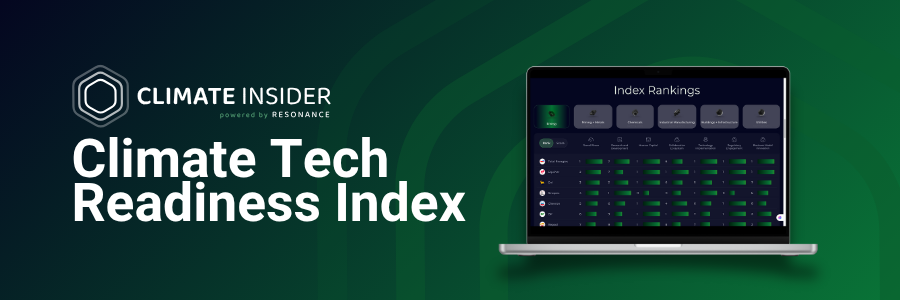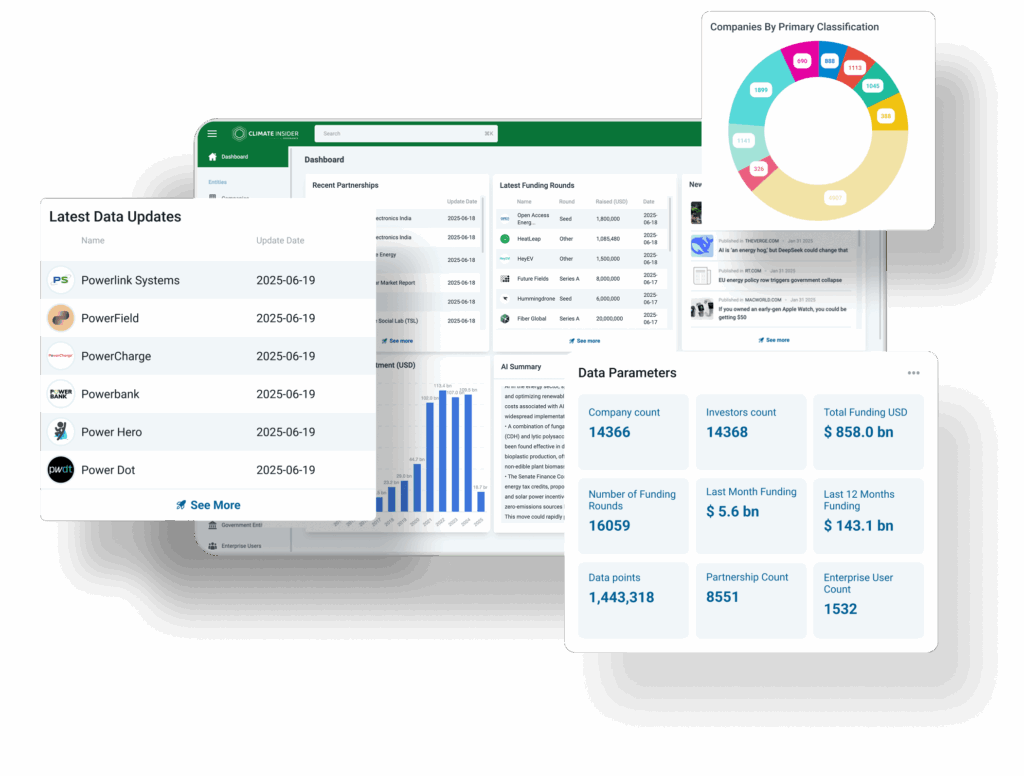Insider Brief:
- The Climate Insider has launched the Climate Technology Readiness Index.
- The index weighs and compares the level of climate technology adoption readiness between companies across emissions-intensive industries.
- Backed by TCI market intelligence, data, and supplementary analysis, focuses on firms’ organizational capabilities, research and development (R&D) investment, and climate industry partnerships.
The Climate Insider has launched the Climate Technology Readiness Index to compare the level of readiness of organizations across emissions-intensive industries including oil & gas, chemicals, mining and metals, transportation, buildings and infrastructure, and power generation to adopt climate tech.
The Problem
The climate technology sector faces a critical deployment gap across emissions-intensive industries including oil & gas, chemicals, and power generation. While $1.8 trillion flows annually into climate tech investment, less than half of companies with net-zero commitments have deployed commercial-scale climate technologies.

Traditional climate indices focus on what companies promise through commitments and disclosure quality, but executives in emissions-intensive industries need intelligence on what organizations can actually execute. With regulatory mandates accelerating globally—from EU carbon border adjustments to industry-specific emissions reduction requirements—companies across heavy industry face urgent decisions about technology deployment worth billions in capital allocation.
The challenge extends beyond individual companies—the broader climate tech ecosystem lacks transparency around which organizations possess the structural foundations necessary for successful technology adoption and scaling across hard-to-abate industries such as steel, cement, chemicals, and heavy manufacturing.
The Solution (The Index)
The Climate Insider has launched the Climate Technology Readiness Index to address this intelligence gap by measuring organizational adoption readiness across emissions-intensive industries including oil and gas, chemicals, mining and metals, transportation, buildings and infrastructure, and power generation.
The index evaluates where organizations stand on the path to climate tech adoption, assessing capacity for technology deployment, structural foundations for operational integration, and strategic ecosystem positioning. Rather than measuring commitments or communications strategies, our assessment focuses on adoption readiness—the preparedness to successfully integrate and scale climate tech solutions across hard-to-abate industries.
“Traditional climate indices tell you what companies promise, but executives directing corporate investment strategies need to know what actually works. Our Index seeks to fill that intelligence gap by measuring who’s actually ready to execute,” according to Nicholas Palaschuk, Director of Climate Insider.
How It Works & What It Measures
The index combines proprietary data from The Climate Insider market intelligence platform with verified public disclosures to evaluate adoption readiness across six core dimensions. This methodology provides a granular assessment of each organization’s preparedness to successfully integrate and scale climate technologies across emissions-intensive industries:
- Research & Development – Assesses R&D infrastructure investments and innovation spending (capacity building for future deployment)
- Human Capital & Governance – Evaluates organizational structures, leadership, and workforce development programs (foundational capabilities)
- Collaborative Ecosystem – Maps partnerships, collaborations, and investments (network positioning and access to capabilities)
- Regulatory Engagement – Examines policy positioning and risk disclosure implementation (preparedness for regulatory environment)
- Business Model Innovation – Analyzes strategic integration and capital allocation patterns (structural readiness for transition)
- Technology Implementation – Verifies operational climate technology deployments and project execution (actual deployment capacity and scaling capability)
The index launches with oil and gas as the inaugural industry due to the sector’s critical role in global energy transition and immediate regulatory pressures. Future assessments will expand to include chemicals, mining and metals, power generation and other emissions-intensive industries, with each evaluation featuring industry-specific adoption readiness indicators.
For each industry, the assessment evaluates industry-specific adoption readiness across relevant technologies—such as carbon capture and storage for cement and steel, methane monitoring for oil and gas, electrification for mining operations, and alternative feedstocks for chemical manufacturing tailored to industry decarbonization pathways.
This industry-calibrated approach applies customized criteria, indicators, and weighting systems for more accurate analysis, enabling precise benchmarking against direct industry peers rather than generic cross-sector comparisons.
“We evaluate over 40 industry-specific indicators to identify organizations with the structural foundations and deployment capacity to succeed in their respective industry transitions. Our methodology reveals whether companies can successfully scale industry-appropriate climate technologies—intelligence that could mean billions in avoided stranded assets or successful technology investments,” said Nicholas Palaschuk.
Why It Matters
As companies across emissions-intensive industries navigate regulatory mandates, evolving market conditions, and decarbonization timelines, the Climate Tech Readiness Index provides critical intelligence for strategic decision-making. Organizations can identify specific capability gaps, evaluate potential partners based on ecosystem positioning, and make informed capital allocation decisions for climate technology investments across their industry context.
For organizations ranking lower on specific dimensions, the index illuminates precise capability gaps—such as R&D infrastructure deficiencies or partnership network weaknesses—enabling targeted improvement strategies. The assessment serves as a diagnostic tool for accelerating adoption readiness rather than simply ranking performance.
For the broader climate tech ecosystem, this tool creates transparency around implementation readiness across hard-to-abate industries, accelerates strategic partnership formation, and enables targeted resource allocation to organizations positioned for successful climate tech adoption. The index bridges the critical gap between climate tech innovation and real-world deployment success by revealing which organizations have the structural foundations necessary for scaling solutions in their respective industries.
With regulatory frameworks like EU carbon border adjustments, transportation emissions standards, and building performance mandates accelerating globally, the index provides essential intelligence for navigating industry-specific decarbonization requirements across our six target industries.
Call to Action
Organizations seeking to understand their adoption readiness positioning or improve their climate technology preparedness are encouraged to engage with the Climate Insider for comprehensive analysis and strategic guidance.
The index serves as a continuous improvement benchmark, updated semi-annually to track progress over time. Companies can leverage these insights to develop targeted action plans, identify strategic partnership opportunities, and strengthen their organizational foundations for successful climate tech adoption within their industry context.
Explore the inaugural oil & gas industry rankings and methodology at index.climateinsider.com, or contact our team for industry-specific benchmarking insights as we expand across emissions-intensive industries.







